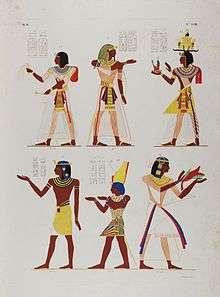Ippolito Rosellini
| Ippolito Rosellini | |
|---|---|
 Bust of Ippolito Rosellini | |
| Born |
13 August 1800 Pisa |
| Died |
4 June 1843 (aged 42) Pisa |
| Cause of death | possibly malaria |
| Nationality | Italian |
| Occupation | Egyptologist |
| Known for | I Monumenti dell'Egitto e della Nubia |
| Spouse(s) | Zenobia Cherubini |
| Parent(s) |
Giovan Battista Rosellini M.Angiola Biagetti |
Niccola Francesco Ippolito Baldassarre Rosellini, known simply as Ippolito Rosellini[1] (13 August 1800 – 4 June 1843) was an Italian Egyptologist. A scholar and friend of Jean-François Champollion, he is regarded as the founder of Egyptology in Italy.[2]
Biography
He was born in Pisa, eldest son of a family originally from Pescia.[1] After studying Hebrew and graduating in theology at the University of Pisa in 1821, Rosellini studied oriental languages under Giuseppe Mezzofanti at Bologna until 1824, when he became professor of the same subject at the University of Pisa.[3][2]
He was the first disciple, a great friend and an associate of Jean-François Champollion. They met in Florence in August 1825, during Champollion's journey to study the important Egyptological collections in Turin, Rome and Florence.[3] In 1827, he went to Paris for a year in order to improve his knowledge of the method of decipherment proposed by Champollion. Here, he met and then married Zenobia, daughter of the Italian composer Luigi Cherubini. A year later, Rosellini accompanied Champollion in the latter's Egyptian exploration also known as the Franco-Tuscan expedition, as the leader of the Tuscan group (1828-29).[2] The expedition was financed by the Grand-duke of Tuscany, Leopold II, and King Charles X of France.

Champollion's sudden death in 1832 left to the saddened Rosellini the whole responsibility of publishing the report of the expedition: between 1832 and 1843 he exposed the results in his most famous work, I Monumenti dell'Egitto e della Nubia, composed of three parts and nine volumes for a total of 3,300 text pages and 395 illustrated plates.[2]
Since 1836, Rosellini's health started to decline possibly due to malaria, which ultimately led to his death on 4 June 1843 in Pisa.[4] All his papers were donated to the library of the University of Pisa, while the last volume of the Monumenti was published posthumously in 1844.[2]
Selected works
- 1826. Di un bassorilievo egiziano della imp. e r. Galleria di Firenze
- 1830. Breve notizia degli oggetti di antichità egiziane riportate dalla Spedizione letteraria toscana in Egitto e nella Nubia, eseguita negli anni 1828-29 ed esposti al pubblico nell'Accademia delle arti e mestieri in S. Caterina
- 1832-44. I Monumenti dell'Egitto e della Nubia, disegnati dalla spedizione scientifico-letteraria Toscana in Egitto: distribuiti in ordine di materie, interpretati ed illustrati
- 1832. Parte I. Monumenti storici, tomo I
- 1833. Parte I. Monumenti storici, tomo II
- 1834. Parte II. Monumenti civili, tomo I
- 1834. Parte II. Monumenti civili, tomo II
- 1836. Parte II. Monumenti civili, tomo III
- 1838. Parte I. Monumenti storici, tomo III, parte I
- 1839. Parte I. Monumenti storici, tomo III, parte II
- 1839. Parte I. Monumenti storici, tomo IV
- 1841. Parte I. Monumenti storici, tomo V
- 1844 (posthumous). Parte III. Monumenti di culto, tomo unico
- 1837. Elementa Linguae Aegyptiacae, vulgo Copticae (ed. by L.M. Ungarelli).[2]
References
Bibliography
| Wikimedia Commons has media related to Ippolito Rosellini. |
- Bardelli, Giuseppe (1843). Biografia del professore Ippolito Rosellini. Florence: Tipografia Piatti. Retrieved June 13, 2015.
- Attribution
![]() This article incorporates text from a publication now in the public domain: Chisholm, Hugh, ed. (1911). "Rosellini, Ippolito". Encyclopædia Britannica (11th ed.). Cambridge University Press.
This article incorporates text from a publication now in the public domain: Chisholm, Hugh, ed. (1911). "Rosellini, Ippolito". Encyclopædia Britannica (11th ed.). Cambridge University Press.